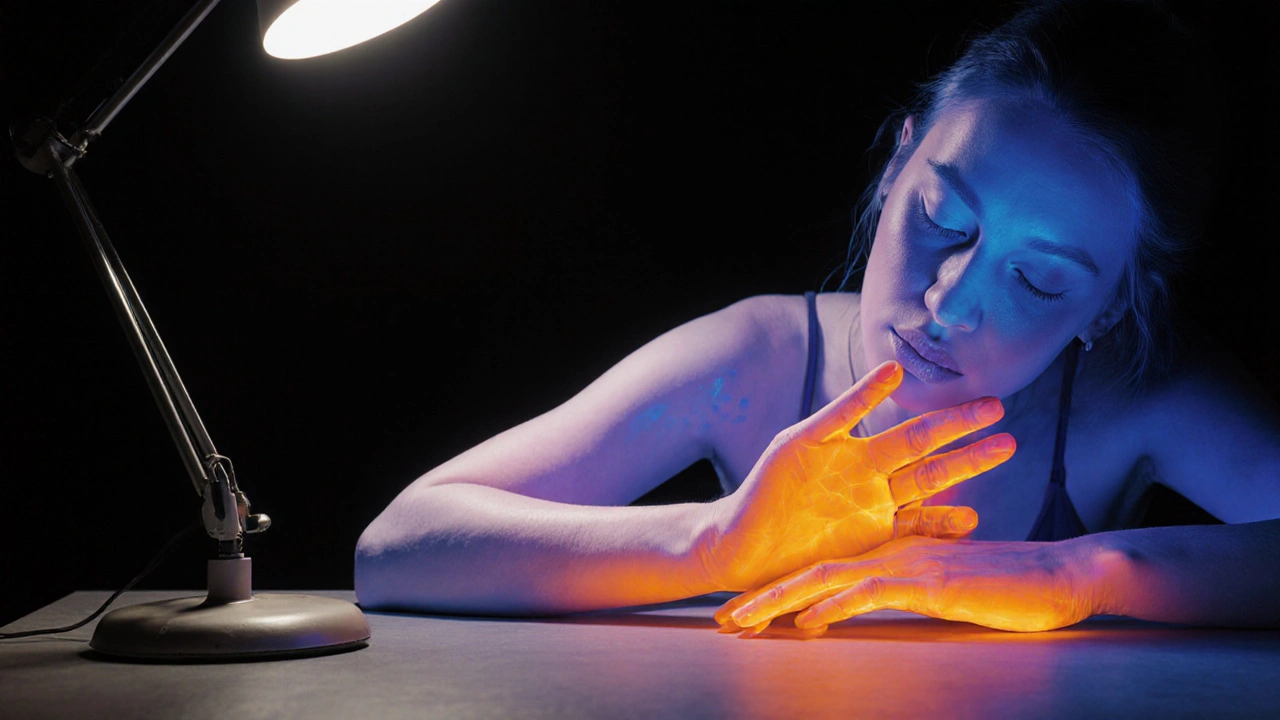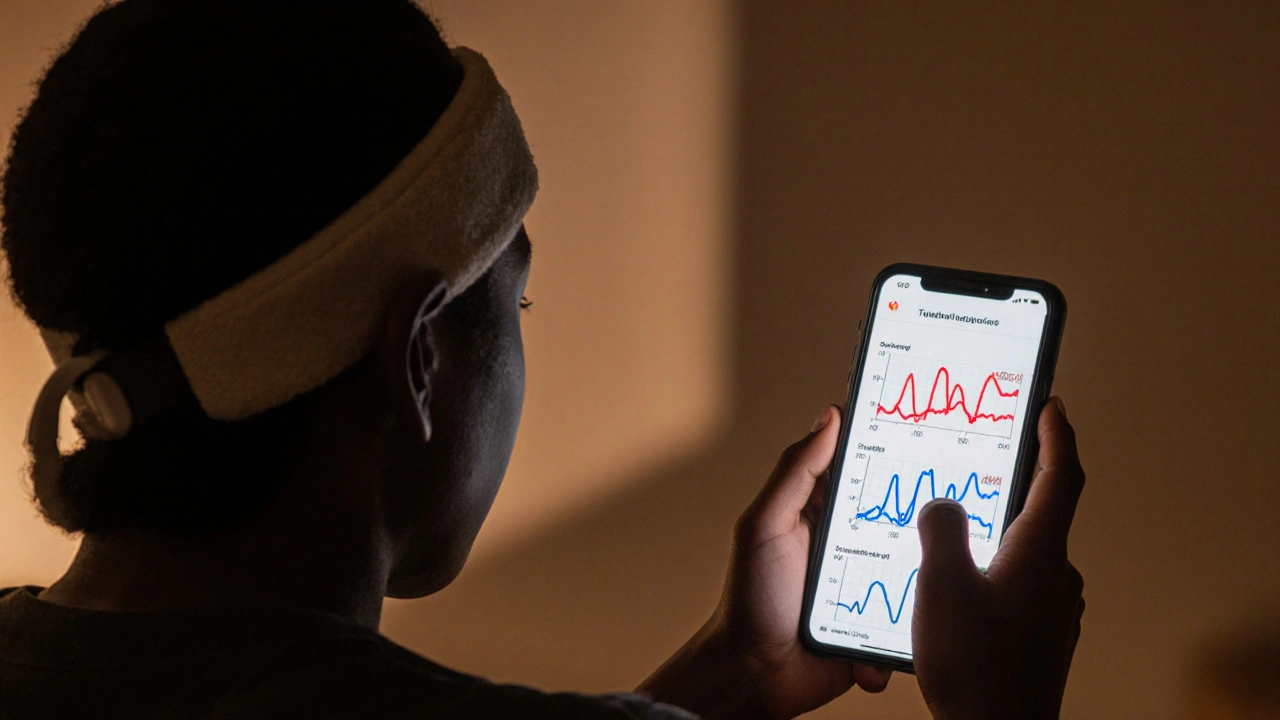Biofeedback Type Finder
Discover which type of biofeedback is most suitable for your wellness goals. Answer a few questions to get personalized recommendations.
What if you could learn to calm your nervous system just by watching your own heartbeat? Or reduce chronic headaches by noticing when your muscles tense up? This isn’t magic. It’s biofeedback - a simple, science-backed way to take control of your body’s automatic responses.
What Biofeedback Actually Does
Biofeedback is a technique that uses sensors to measure physical signals your body produces - like heart rate, muscle tension, skin temperature, or brainwaves - and turns them into real-time visual or sound cues. You see or hear these signals, and over time, you learn how to change them consciously.
It sounds strange at first. Your heart beats, your muscles tighten, your sweat glands activate - all without you thinking about it. But biofeedback gives you a window into those hidden processes. Instead of guessing whether you’re stressed, you see it on a screen. Instead of hoping your tension headaches will go away, you learn exactly when and how they start.
It’s not about forcing yourself to relax. It’s about training your brain to recognize subtle body cues and respond differently. Think of it like learning to ride a bike. At first, you wobble. But with feedback - seeing your balance, feeling the handlebars - you adjust. Biofeedback works the same way, but for your internal state.
How It Works: The Science Behind the Signals
Biofeedback devices connect to your body through small sensors. These sensors pick up data like:
- Electromyography (EMG): Measures muscle tension, often used for headaches, back pain, or jaw clenching.
- Thermal biofeedback: Tracks skin temperature, which drops when you’re stressed and rises when you relax.
- Heart rate variability (HRV): Shows how your heart rhythm changes with breathing - a strong indicator of nervous system balance.
- Electrodermal activity (EDA): Measures sweat gland activity, linked to emotional arousal.
- Electroencephalography (EEG): Monitors brainwave patterns, used for focus, sleep, and anxiety.
These signals are displayed on a screen as graphs, tones, or even games. For example, you might see a bar that rises when your shoulders tighten. Or hear a calming tone that gets louder as your hands warm up. Your brain picks up the pattern. You start to notice, Wait - when I think about my boss, my shoulders spike. Then you learn to breathe, release, and reset before the tension becomes pain.
Studies from the American Psychological Association show biofeedback is effective for migraines, high blood pressure, anxiety, and even urinary incontinence. A 2023 meta-analysis of 42 clinical trials found that biofeedback reduced migraine frequency by 45% on average - comparable to medication, but without side effects.
Who Benefits Most From Biofeedback?
Biofeedback isn’t a cure-all, but it’s especially powerful for people who:
- Struggle with chronic stress but don’t respond well to meditation or breathing exercises alone
- Have tension headaches, jaw pain, or neck stiffness that won’t go away
- Experience anxiety attacks and feel out of control during them
- Suffer from insomnia and can’t quiet their racing mind
- Have high blood pressure and want to reduce medication dependence
It’s also helpful for athletes, musicians, and performers who need to stay calm under pressure. A 2024 study of professional orchestra players found that those using HRV biofeedback reported 60% less performance anxiety and improved focus during live shows.
One woman in Melbourne, Sarah, started biofeedback after years of migraines. She’d tried acupuncture, yoga, and meds - nothing stuck. With EMG biofeedback, she learned her headaches started 20 minutes before she felt pain. Her shoulders were already tight. By catching that early signal, she could do a quick shoulder drop and deep breath. Within six weeks, her headaches dropped from five times a week to once a month.

Types of Biofeedback: Which One Is Right for You?
Not all biofeedback is the same. Here’s how to match the right type to your goal:
| Goal | Best Biofeedback Type | What You’ll Learn |
|---|---|---|
| Reduce stress and anxiety | Heart Rate Variability (HRV) | How breathing affects your nervous system |
| Chronic headaches or jaw pain | Electromyography (EMG) | When and where your muscles tighten |
| Improve sleep | EEG (brainwave) biofeedback | How to shift from alert to calm brain states |
| Lower blood pressure | Thermal biofeedback | How warmth in hands signals relaxation |
| Manage panic attacks | EDA (sweat response) | Early signs of emotional overload |
HRV biofeedback is the most widely used today because it’s easy to measure with simple wearable devices. Many people start here because it connects directly to breathing - something we can control right away.
How to Get Started With Biofeedback
You don’t need a clinic to begin. Here’s how to start today:
- Choose your goal. Are you trying to sleep better? Reduce anxiety? Ease a headache? Pick one.
- Get a simple device. Look for FDA-cleared devices like the HeartMath InnerBalance, Theta Health, or Muse S headband. These connect to your phone and give real-time feedback.
- Set aside 10 minutes a day. Sit quietly. Focus on your breath. Watch the screen. Don’t force results - just observe.
- Notice patterns. Do your heart rate spike after checking emails? Do your shoulders tighten before bed? Write it down.
- Experiment with responses. Try breathing slower. Unclench your jaw. Roll your shoulders. See what changes the signal.
Most people see results in 4-6 weeks with daily practice. The key isn’t perfection - it’s awareness. You’re not trying to be calm. You’re learning how to recognize when you’re not.
What to Avoid With Biofeedback
Biofeedback is safe, but people often make these mistakes:
- Expecting instant results. This isn’t a magic button. It’s skill-building. Like learning piano, progress comes slowly.
- Over-relying on the device. The goal is to internalize the feedback. Eventually, you should feel your tension without a screen.
- Using cheap, unregulated gadgets. Many apps claim to do biofeedback but just measure pulse with your phone camera. These aren’t accurate. Look for devices cleared by the FDA or TGA (Therapeutic Goods Administration).
- Skipping the mental part. The tech shows you the signal. But you have to learn how to respond. That’s where the real work happens.
Also, biofeedback isn’t a replacement for medical care. If you have serious health conditions - like epilepsy, heart disease, or severe depression - talk to your doctor before starting.

Biofeedback vs. Meditation: What’s the Difference?
People often ask: “Isn’t this just like meditation?”
They’re similar - both help you calm down. But here’s the key difference:
- Meditation asks you to quiet your mind and observe thoughts without judgment. You’re working from the inside out.
- Biofeedback gives you an external mirror. You see your body’s response and adjust based on data. You’re working from the outside in.
For someone who finds meditation frustrating - “I can’t stop thinking!” - biofeedback can be a game-changer. It gives you something tangible to focus on. You’re not fighting your thoughts. You’re watching your heart rate. And that’s easier.
Many people combine both. They use biofeedback to learn how to relax, then use meditation to deepen it.
Where to Find Professional Biofeedback
If you want guided training, look for licensed therapists with biofeedback certification. In Australia, check with the Applied Psychophysiology and Biofeedback Society or ask your GP for a referral. Sessions usually cost $80-$150 per hour. Insurance sometimes covers it if you have a chronic condition.
Many clinics now offer group biofeedback programs for stress or chronic pain. These are often more affordable and provide peer support.
For most people, though, starting with a home device is enough. You can build the skill on your own - then see a professional if you hit a plateau.
The Bigger Picture: Biofeedback as a Lifelong Skill
Biofeedback isn’t a quick fix. It’s a way to build body literacy - the ability to listen to what your body is telling you before it screams.
Think of it like having a dashboard in your car. You don’t need to check the fuel gauge every minute. But when the light comes on, you know what to do. Biofeedback gives you that dashboard for your nervous system.
Over time, you stop needing the screen. You just know. Your shoulders feel tight. Your hands feel cold. Your breath gets shallow. And you respond - before stress becomes pain, before anxiety becomes panic.
That’s the real power of biofeedback. It doesn’t just reduce symptoms. It gives you back control - over your body, your reactions, and your daily life.
Is biofeedback scientifically proven?
Yes. Over 1,000 peer-reviewed studies support biofeedback for conditions like migraines, hypertension, anxiety, and chronic pain. The American Psychological Association recognizes it as an evidence-based treatment. Devices like HRV and EMG biofeedback have FDA and TGA clearance for clinical use.
Can I do biofeedback at home?
Absolutely. Many FDA-cleared devices are designed for home use - like the HeartMath InnerBalance, Muse headband, or BioForce HRV. These connect to your smartphone and guide you through short sessions. You don’t need a therapist to start, though professional coaching can speed up results.
How long does it take to see results?
Most people notice changes in 2-4 weeks with daily 10-minute sessions. For chronic issues like migraines or high blood pressure, it may take 6-8 weeks to see significant improvement. Consistency matters more than session length.
Is biofeedback safe for everyone?
Yes, for most people. It’s non-invasive and has no side effects. But if you have a pacemaker, epilepsy, or severe cardiovascular disease, consult your doctor first. Also, avoid using biofeedback as a replacement for medical treatment of serious conditions.
What’s the difference between biofeedback and a fitness tracker?
Fitness trackers measure steps, calories, or sleep stages - they don’t help you change your body’s responses. Biofeedback devices give you live feedback on physiological signals (like muscle tension or heart rhythm) so you can learn to control them. It’s training, not just tracking.







